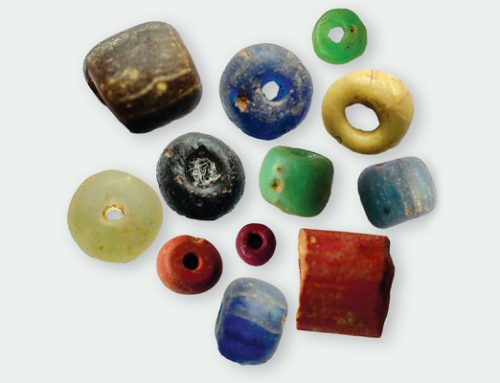
In 2001, archaeologist Michael Petraglia was picking through boxes in a museum storeroom in Riyadh, the dusty capital of Saudi Arabia. Petraglia, who had been coaxed by Saudi colleagues to examine the country’s prehistory on a Fulbright scholarship, was stunned to find huge numbers of stone tools crafted by ancient hunter-gatherers and apparently tens or even hundreds of thousands of years old.

Michael Petraglia in his element, near the oasis of Tayma in Saudi Arabia.
PHOTO: RICHARD JENNINGS/UNIVERSITY OF OXFORD (2)
Like most researchers interested in human origins, Petraglia had dismissed the Arabian Peninsula as a place of marginal interest. Conventional wisdom held that humans settled this inhospitable environment only a few thousand years ago, when domesticated animals like goats and camels made it habitable. “Arabia was thought of as empty,” he says.
Intrigued by the tools, he set out to explore the harsh landscape. Walking the sand dunes, the lanky American-born scientist spotted the outlines of long, dry lakes—and littering their vanished shores, he saw innumerable gray and brown triangular pieces of rock expertly knapped by human hands. Today, these deserts are home only to hardy Bedouin nomads and the occasional crew drilling for oil. In the distant past, however, large numbers of our ancestors apparently found this land a congenial home. “I was blown away,” recalls Petraglia, now a professor at the University of Oxford in the United Kingdom. “There were artifacts everywhere—it was astounding.”
The finds had particular relevance for him. Many researchers contend that modern humans did not expand beyond their African homeland until 55,000 years or so ago, moving quickly eastward around the Indian Ocean to reach Australia within 10,000 years. But even before he spotted those artifacts in the desert, Petraglia had suspected that humans left their home continent tens of thousands of years earlier and wandered slowly eastward, deep into Asia. An ancientArabia that welcomed modern humans with lakes and greenery fitted neatly into these ideas: “I understood immediately that it was a steppingstone toward South Asia,” he says.
Busy with excavations in India, where he found stone tools amid 74,000-year-old volcanic ash—evidence, he says, that our ancestors reached India by that date—Petraglia waited a decade before he returned to Saudi Arabia. His black hair now shading to gray, he is no longer a lone researcher on a brief scholarship. Armed with a $3.3 million grant from the European Research Council (ERC) and backed by a Saudi prince, Petraglia oversees an effort involving a dozen institutions and some 50 researchers from around the world who are fanning out across the kingdom to uncover Arabia’s role in human dispersal out of Africa.
“Climate is at the heart of this,” says Petraglia, who organized a meeting in Oxford in April to discuss new Arabian finds. The human artifacts, though abundant, are mostly undated and difficult to link to specific cultures. But his group and others canvassing neighboring Oman and the United Arab Emirates have amassed evidence that during the crucial time when human ancestors may have left Africa, the Arabian Peninsula was, at least at intervals, temptingly wet andgreen.
Petraglia’s group is using satellite data to map ancient lakes and river systems, then traversing the vast region to confirm their findings on the ground. All told, they have pinpointed more than a thousand ancient lakes that were filled with water off and on during the past few hundred thousand years, along with hundreds of artifact-filled sites. In the past 3 years, his team and others dated a handful of these sites, the earliest of them to 125,000 and 211,000 years ago. What’s still missing are bones of the people who left the artifacts, which could reveal who the peninsula’s ancient inhabitants were—modern humans or extinct human relatives.
Already, though, Petraglia is convinced that rather than skirting Arabia, modern humans on their way from Africa into the wider world may have colonized it, hopping from lake to lake across the peninsula in pursuit of game and useful plants—a slow, meandering dispersal rather than the rapid march commonly envisioned. In time, he is likely to have the bones that could confirm this scenario—or contradict it.
“With all the activity in Arabia these days, Petraglia’s team is going to find a human fossil eventually,” says archaeologist John Shea of Stony Brook University in New York. “It is just a matter of time.”
 ACCORDING TO A SAYING of the Prophet Muhammad, Judgment Day will not come “until the land of the Arabs returns to its state of lush pasture and abundant rivers.” The notion that the sand dunes and bare mountains of Arabia were once verdant has long demanded a leap of faith. The region includes the Rub al Khali, Arabic for “the Empty Quarter,” the planet’s largest sand desert, a Texas-sized wilderness where temperatures soar above 50°C and rain averages fewer than 30 millimeters annually.
ACCORDING TO A SAYING of the Prophet Muhammad, Judgment Day will not come “until the land of the Arabs returns to its state of lush pasture and abundant rivers.” The notion that the sand dunes and bare mountains of Arabia were once verdant has long demanded a leap of faith. The region includes the Rub al Khali, Arabic for “the Empty Quarter,” the planet’s largest sand desert, a Texas-sized wilderness where temperatures soar above 50°C and rain averages fewer than 30 millimeters annually.
Yet even today, Arabia’s landscape is not entirely dry or sandy. In the extreme southern province of Dhofar in Oman, for example, more than 200 millimeters of rain green the hills most summers, when the annual Indian Ocean monsoon grazes the Omani coast. And climate models suggest that during the intervals between ice ages, this greening spreads across the peninsula. According to the models, the monsoon system then slips northward, drenching what is now desert for a few thousand years or more before resuming its more typical southerly course.
The most pronounced period of wet and warm weather in the past few hundred thousand years took place about 125,000 years ago, during the height of the last interglacial. Less dramatic monsoon shifts came about 80,000 and 55,000 years ago. “When the water pump is on, brown Arabia turns green,” explains geoarchaeologist Adrian Parker of Oxford Brookes University in the United Kingdom, who’s involved in the project.
Other geologic clues, such as paleolakes, mineral deposits in caves, and alluvial fans, support the paleoclimate models, pointing to moist periods of varying length, says Richard Jennings, a University of Oxford archaeologist and climate expert who recently spent 4 months gathering field data. During the wet spells, lakes filled up, rivers ran, and a savannalike environment resembling that of today’s East Africa dominated Arabia. “There could be tens of thousands of former lakes and wetlands” in Arabia during the wet periods, says Paul Breeze of King’s College London, a hydrologist who has already identified 1300 paleolake and wetland sites in just 10% of the peninsula.
Members of a Petraglia expedition recently explored one dry lakebed near the town of Jubbah, about 350 kilometers north of Riyadh in the Kentucky-sized Nefud Desert that lies between Jordan and central Arabia. “Jubbah was a huge lake, thick with reeds and full of mollusk beds,” during wet periods, says University of Oxford archaeologist Ash Parton. Given the botanical and faunal remains, the lake “may have been a long-term oasis”—a refuge for plants, animals, and humans even during dry eras, he says. Another paleolake called Mundafan, deep in the forbidding Empty Quarter, was once surrounded by grasslands, as shown by studies of microscopic plant remains called phytoliths.
Breeze’s team is also mapping a river system, now largely hidden by dunes or shrunk to seasonal wadis, which once flowed north out of the Yemeni highlands, across central Arabia, and into a broad river valley that today is the shallow Persian Gulf. Another system included a river, 2 meters deep, 20 meters wide, and flanked by grasses and palms, that gushed out of the mountains of Oman and traveled 400 kilometers across what is now barren land, according to phytolith and sedimentology work in the United Arab Emirates by Oxford Brookes’ Parker.

Freshwater snails (top) and lake sediments show a wetter environment for ancient Arabia.
PHOTO: RICHARD JENNINGS/UNIVERSITY OF OXFORD (2)
Discoveries of ancient animal bones provide additional confirmation that during the past half-million years, Arabia periodically was wet enough to draw fauna from Africa and other parts of Asia. Last October, a team led by the University of Oxford’s Christopher Stimpson found bones of a panther and elephant in a 325,000-year-old fossil field near the oasis town of Tayma in the Nefud.
How African animals crossed into Arabia—whether across the Sinai Peninsula at one end of the Red Sea or over the Bab el Mandeb strait separating Djibouti from Yemen at the other end (see map)—is a matter of debate. Today the southern passage (the name is Arabic for “gateway of anguish” because of its treacherous currents) is 30 kilometers wide. It would have been wider during warmer and wetter eras, although an island chain north of the strait may have made the crossing possible. Baboons, ostrich, mongoose, leopard, cheetah, and genet likely took this route, says geographer Nick Drake of King’s College London.
Modern humans appear to have taken the northern route, into the Sinai Peninsula, during the crucial wet period 125,000 years ago. Human bones—the oldest with modern traits found outside Africa—have been excavated from two Israeli caves, and dated to as long ago as 120,000 years (Science, 13 May 2005, p. 965). Scientists have long assumed that these early wayfarers died out before spreading deeper into Asia, in part because the terrain between what is now Israel and Iran was hostile desert. “This model is so entrenched,” says Petraglia, with a note of impatience. “It was difficult to publish anything to the contrary.”
But if Arabia was an appealing route rather than a barrier, he says, then these early modern humans could have tracked familiar game and plants across a welcoming savanna dotted with lakes and crisscrossed with rivers, ultimately crossing into the Indian subcontinent. Arriving in time to experience the fall of ash from the Indonesian volcano of Toba 74,000 years ago, India’s early moderns crafted tools resembling those in Africa, he argues. And if Arabia was indeed a steppingstone for eastward-journeying modern humans, its sands must hold stones and bones recording their passage.
EARLIER WAVES OF HOMININS certainly left their mark. The University of Oxford’s Huw Groucutt recalls his astonishment on stumbling upon one of the largest collections of tools he had ever seen, on the second day of a 2010 survey in the Jubbah region. The stones lay spread out by the thousands across the barren landscape, seemingly as undisturbed as when they were dropped by their ancient users.
Jubbah is no anomaly. Groucutt and others are finding hundreds of sites littered with many thousands of tools. Though few are dated, their styles suggest that substantial populations of archaic hominins made Arabia their home well before modern humans came out of Africa. Along one ancient riverbed in the Nefud, for example, archaeologists found 3000 artifacts on the surface identified as Acheulean, a type of tool first used as early as 1.8 million years ago and linked to Homo erectus.

Ancient people in Arabia left behind tools like this stone point, 7 centimeters high, from paleolake Mundafan. PHOTO: IAN CARTWRIGHT/SCHOOL OF ARCHAEOLOGY, UNIVERSITY OF OXFORD
Most of the Arabian artifacts appear more recent, typical of the Middle Paleolithic—a period from about 200,000 years ago until 45,000 years ago, when modern humans might have been spreading across the peninsula. These carefully prepared cores or cobbles were used to produce predictably shaped flakes for cutting and scraping. These are the kind of artifacts Petraglia saw in the Riyadh storerooms—but their precise ages are unknown. Tools can be dated only if they’ve been dug from dated strata, and the Riyadh artifacts, like thousands of others, were simply picked up from the ground. “Until 2011, there wasn’t a single dated [stone] tool in all of Arabia,” Petraglia says.
In the past 4 years, however, archaeologists have found a handful of buried artifacts that could be dated using optically stimulated luminescence, which reveals how long an object has been buried. One of the most important finds came from near a cave shelter in the United Arab Emirates called Jebel Faya, some 2000 kilometers east of the African coast. There, a team from the University of Tübingen in Germany led by Hans-Peter Uerpmann found tool assemblages that they dated to 125,000 years ago (Science, 28 January 2011, p. 453). The same year, archaeologist Jeffrey Rose and colleagues pinpointed another buried site on the Dhofar coast to about 100,000 years ago. And Petraglia’s team has dated objects from five sites near Jubbah to as early as 211,000 years old, with most clustering between 90,000 and 74,000 years ago.
Researchers are now gleaning dates from about 20 other sites in Arabia, and more datable sites are likely to be uncovered soon. Three-quarters of the paleolakes that Breeze surveyed were rimmed with Middle Paleolithic tools.
THE RELATIVELY RECENT dates of these artifacts suggest that modern humans could have been the toolmakers, and the style of the tools is right, too, say Petraglia, Uerpmann, and Rose. They argue that the Arabian Middle Paleolithic tools bear striking resemblance to those made in Northeast Africa between 125,000 and 70,000 years ago.

Even today the southern edge of Arabia turns green when grazed by the monsoon (top, in Oman), but most of the peninsula stays dry year-round.
PHOTOS: (TOP TO BOTTOM) RANDOLPH CAGUINTUAN/REUTERS; ADRIAN G. PARKER/OXFORD BROOKES UNIVERSITY
That idea got a shot of support from an 8 August paper published online in the Journal of Human Evolution by Eleanor Scerri of the University of Bordeaux in France and colleagues including Groucutt. The team analyzed artifacts from Jubbah and from Northeast Africa and concluded that although the materials differ, the methods of producing cores and flakes are similar. But Scerri says that some Arabian tools look distinct from those of Africa, with regional flavors that suggest diverse populations or even different types of hominins.
Other researchers say that until archaeologists find the bones of the toolmakers, their identity will remain wide open. Chris Stringer, a paleontologist at London’s Natural History Museum, suggests they could have been Neandertals, who survived in Europe until about 40,000 years ago. Although Neandertal remains have not been found south of Iraqi Kurdistan, more than 1500 kilometers north of Riyadh, the new climate data make it conceivable that our extinct cousins, too, were drawn to a green Arabia, Stringer says. “Why not?”
Stony Brook University’s Shea adds that the recently discovered Denisovans, archaic humans apparently once widespread in Asia, could also have fashioned the tools after reaching Arabia from the east. “Nobody knows who or what was running around South Asia back then,” he says. “Why nobody thinks populations could disperse into Arabia from South Asia is a mystery to me.”
A few skeptics adamantly reject the idea of an ancient Arabia bustling with modern humans. To archaeologist Paul Mellars of the University of Cambridge in the United Kingdom, it is inconceivable that modern humans successfully sojourned outside Africa before 55,000 years or so ago. Even then, he says, they did not meander through the Arabian Peninsula but hugged the coast in a quick sprint to Southeast Asia and Australia. “Colonizing the deserts in Arabiawould be a suicidal act,” he says. “You can say Green Arabia, but it was only green for brief periods.” He suggests that any Arabian forays by modern humans were short and ineffectual.
Petraglia admits that the picture remains murky. Until he or others can bring home the bones, “Arabia is a complete unknown when it comes to species,” he says. Meanwhile, he says, a slew of peer-reviewed papers will be published in the next year or two as teams work in the field and lab, sharpening the picture of the ancient green place that might have hosted modern humans.
At the Oxford meeting, Prince Sultan bin Salman, a former shuttle astronaut, pledged to create a Green Arabia Institute devoted to research on climate and the early occupation of Saudi Arabia, a sign that research is likely to continue far beyond the ERC grant that ends in 2017. Petraglia himself will be back on the Arabian sands in November. “I can’t wait to get back out there,” he says. “It’s a gold mine. Without Arabia, we can’t tell an accurate story of human migration.”



